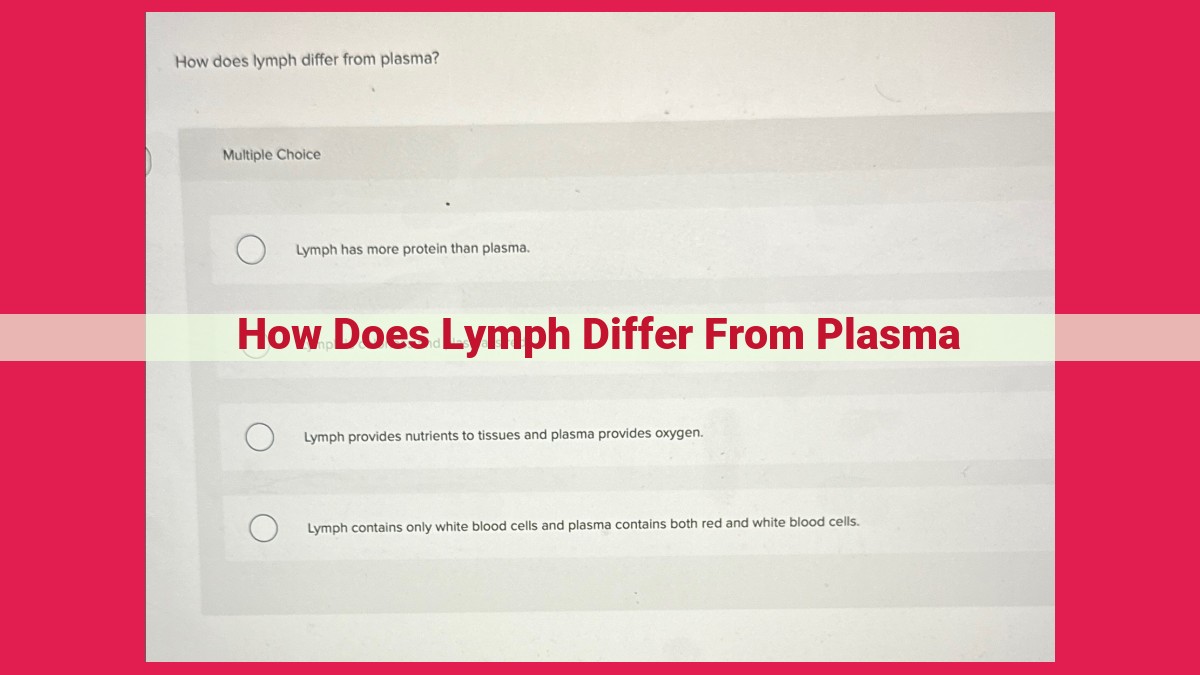Understanding Lymph And Plasma: Specialized Roles In The Circulatory System

Lymph, unlike plasma, contains higher lipids due to dietary absorption. It also carries lymphocytes, essential for immunity, absent in plasma. Lymph lacks clotting factors, preventing clot formation. While plasma transports nutrients and hormones, lymph transports lipids and immune cells, highlighting their specialized roles in the circulatory system.
Plasma and Lymph: Unraveling the Differences in Composition
In the intricate tapestry of our circulatory system, two vital fluids flow: plasma and lymph. While they share a common origin, these fluids carry distinct compositions that shape their unique roles.
Plasma: The Nutrient-Rich Lifeline
Plasma, the liquid portion of blood, is an intricate symphony of dissolved nutrients, hormones, proteins, and other vital substances. It serves as the primary transporter of oxygen, glucose, and other nutrients to the body’s cells. Additionally, plasma carries hormones that regulate various physiological processes.
Lymph: The Lipid-Rich Defender
Lymph, a clear fluid that circulates through the lymphatic system, differs significantly from plasma in its composition. Lipids (fats) are far more abundant in lymph, contributing to its milky appearance. This high lipid content is essential for transporting fats from the digestive system to the bloodstream.
Lipid Content: A Tale of Function
The higher lipid content of lymph stems from its role in absorbing fats from the small intestine. These fats are packaged into lipoproteins (fat-carrying molecules) and transported via lymph to the bloodstream. In contrast, plasma’s lower lipid content reflects its primary function of transporting water-soluble substances.
Moreover, the lipid content of lymph contributes to its unique functions. It aids in lubricating tissues and supporting immune cells. The fatty acids present in lymph also provide energy to immune cells, enhancing their ability to fight infections.
Cell Content: The Lymphocytes and the Immune Guardians
Lymph, a clear fluid that circulates throughout our body, holds a hidden treasure—lymphocytes. These specialized cells are the cornerstones of our immune system, constantly patrolling our bodies, ready to defend against invading pathogens.
Unlike plasma, the liquid component of blood, lymph contains a significant population of lymphocytes. These immune cells are essential for fighting infections and maintaining overall immune function. They include:
- B cells, which produce antibodies to neutralize harmful substances
- T cells, which destroy infected cells and regulate immune responses
In contrast, plasma lacks lymphocytes, making it less capable of directly combating infections. However, plasma does contain various proteins and molecules involved in immune defense, such as antibodies and complement proteins.
By having lymphocytes in lymph, our bodies can quickly and efficiently respond to threats. Lymphocytes can identify and destroy pathogens before they spread throughout the bloodstream, providing a vital first line of defense against disease.
Why Lymph Can’t Form Clots: Understanding Coagulation
In the intricate network of our circulatory system, two fluids play vital roles: plasma and lymph. While similar in appearance, they differ significantly in composition and function. One striking difference is their ability to form clots.
Plasma, the liquid component of blood, contains clotting factors, specialized proteins that work together to seal off damaged blood vessels. When a blood vessel is injured, the clotting factors are activated and form a mesh-like network that traps blood cells and platelets, creating a protective barrier.
Lymph, on the other hand, lacks clotting factors. This absence makes lymph unable to form clots. This is crucial because if lymph were to clot, it could block the lymphatic vessels and disrupt the flow of immune cells and lipids.
The absence of clotting factors in lymph stems from its unique composition. Unlike plasma, which contains primarily water and proteins, lymph is rich in lipids, particularly triglycerides. These lipid molecules physically interfere with the interactions between clotting factors, making it impossible for them to form a stable clot.
The inability of lymph to clot is essential for its function. Its primary role is to transport lipids and immune cells away from tissues and back into the bloodstream. If lymph were able to clot, it could trap these substances in the lymphatic vessels and impair their ability to fight infection and maintain homeostasis.
In summary, the absence of clotting factors in lymph is a critical adaptation that ensures its proper function. By preventing clot formation, lymph can effectively transport lipids and immune cells throughout the body without compromising the delicate balance of the circulatory system.
Function: Specialized Roles in the Circulatory System
In the intricate interplay of our bodies, lymph and plasma play distinct yet crucial roles in maintaining our overall health. While both are essential components of the circulatory system, they differ significantly in their composition and functions.
Lymph: Transporting Lipids and Immune Cells
Lymph is a fluid that circulates throughout the body’s lymphatic system. Unlike plasma, which is found within blood vessels, lymph flows through lymphatic vessels, collecting waste products, bacteria, and cellular debris. Notably, lymph contains a higher concentration of lipids, or fats, compared to plasma. This lipid-rich composition enables lymph to effectively transport lipids from the digestive system to the bloodstream.
Furthermore, lymph plays a vital role in immunity. It contains an abundance of lymphocytes, a type of white blood cell that fights infections and maintains immune function. Lymphocytes in lymph are constantly monitoring the body for potential threats, such as bacteria, viruses, and foreign particles. When an infection occurs, lymph transports lymphocytes to the affected area, where they can neutralize pathogens and prevent disease progression.
Plasma: Transporting Nutrients, Hormones, and Molecules
In contrast to lymph, plasma is the liquid component of blood. It constitutes over half of the blood volume and is responsible for transporting a wide range of vital substances throughout the body. Plasma contains proteins, hormones, nutrients, electrolytes, and waste products.
Plasma is essential for delivering oxygen, nutrients, and hormones to cells throughout the body. It also removes waste products, such as carbon dioxide and urea, which are transported to the kidneys and lungs for excretion. Additionally, plasma plays a crucial role in blood clotting, containing clotting factors that enable the formation of blood clots to stop bleeding when necessary.